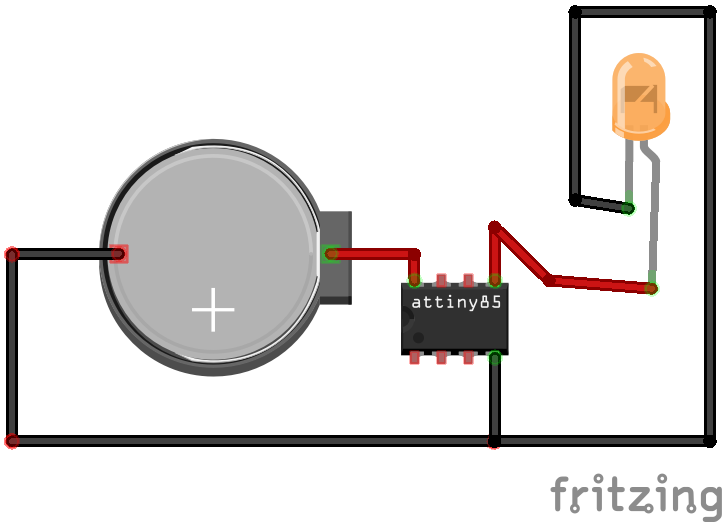Let the wires that connect components become art!
So this is simple circuit sculpture which fades an LED using an ATtiny85.
Also here I will be describing how to program ATtiny microcontrollers using the Arduino IDE.
Build InstructionsWire the Circuit to Flash ATtiny
Connect the Arduino to the ATtiny as follows:
- Arduino +5V ---> ATtiny Pin 8
- Arduino Ground ---> ATtiny Pin 4
- Arduino Pin 10 ---> ATtiny Pin 1
- Arduino Pin 11 ---> ATtiny Pin 5
- Arduino Pin 12 ---> ATtiny Pin 6
- Arduino Pin 13 ---> ATtiny Pin 7
Put the 10uF capacitor between ground and the Arduino reset pin. Make sure to keep an eye on the capacitors polarity (ground to ground!).
This capacitor effectively filters out the incoming reset pulses that come from your PC when the Arduino software starts to program your part. Because you want to program a part further downstream, you filter the reset pulses coming into the Arduino. Otherwise, you’d invoke the Arduino’s bootloader and program that Arduino, and that’s not what you want at all. ;-)
Set Up Arduino IDE
- Connect your Arduino, open the IDE, and upload Example> ArduinoISP sketch;
This Arduino-supplied example sketch turns your Arduino into an ISP (in-system programming)
Again;
- Open Arduino IDE
- File > Preferences and in Additional Board Manager URLs: and Copy/Paste this:
- Click OK
- Tools > Board > Manager, install: ATTiny and close Arduino IDE
Configure Arduino IDE Tools Menu
Open Arduino IDE,
(1) Board: ATtiny25/45/85
(2) Processor: ATtiny85
(3) Clock: Internal 1 MHz
(4) Port: COMXX(Arduino Uno)
(5) Programmer: Arduino as ISP
Upload the below given code:
/*
Fading LED with ATtiny85
The analogWrite() function uses PWM, so if you want to change the pin you're
using, be sure to use another PWM capable pin.
This example code is in the public domain.
*/
int led = 0; // the PWM pin the LED is attached to
int brightness = 0; // how bright the LED is
int fadeAmount = 5; // how many points to fade the LED by
void setup() {
pinMode(led, OUTPUT);
}
// the loop routine runs over and over again forever:
void loop() {
analogWrite(led, brightness);
// change the brightness for next time through the loop:
brightness = brightness + fadeAmount;
// reverse the direction of the fading at the ends of the fade:
if (brightness <= 0 || brightness >= 255) {
fadeAmount = -fadeAmount;
}
// wait for 30 milliseconds to see the dimming effect
delay(30);
}
Also you can get code and circuit diagram from my GitHub page..
Circuit Diagram
ATtiny Pinout
Use copper wire for the connection and solder it to leads. Make it is like candle as per your imagination and idea.
The following video shows how my circuit sculpture looks:
Thank you! Happy making!











Comments
Please log in or sign up to comment.